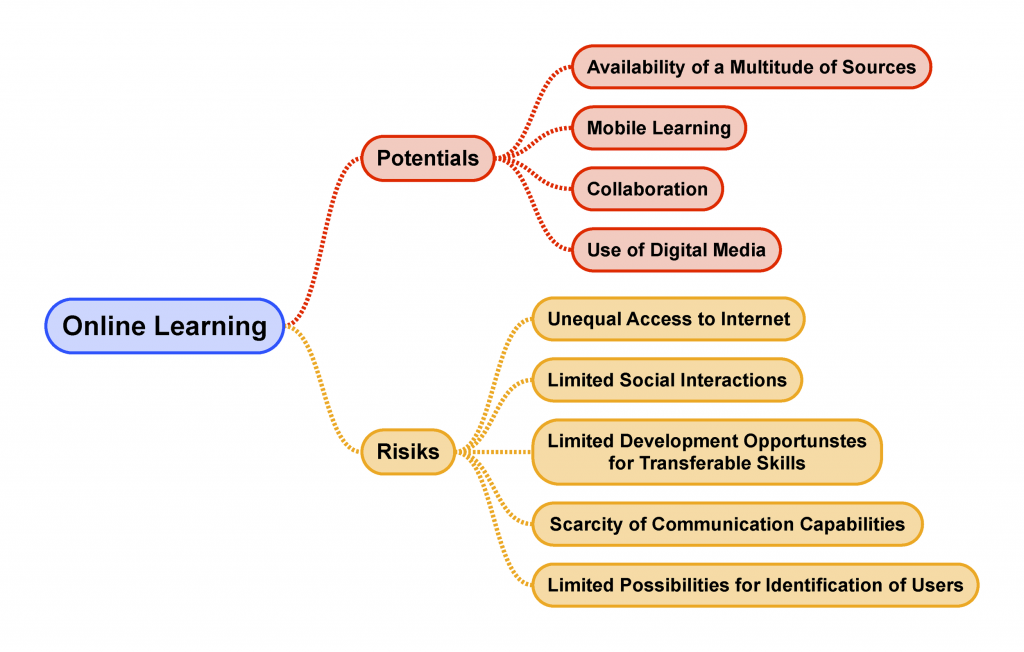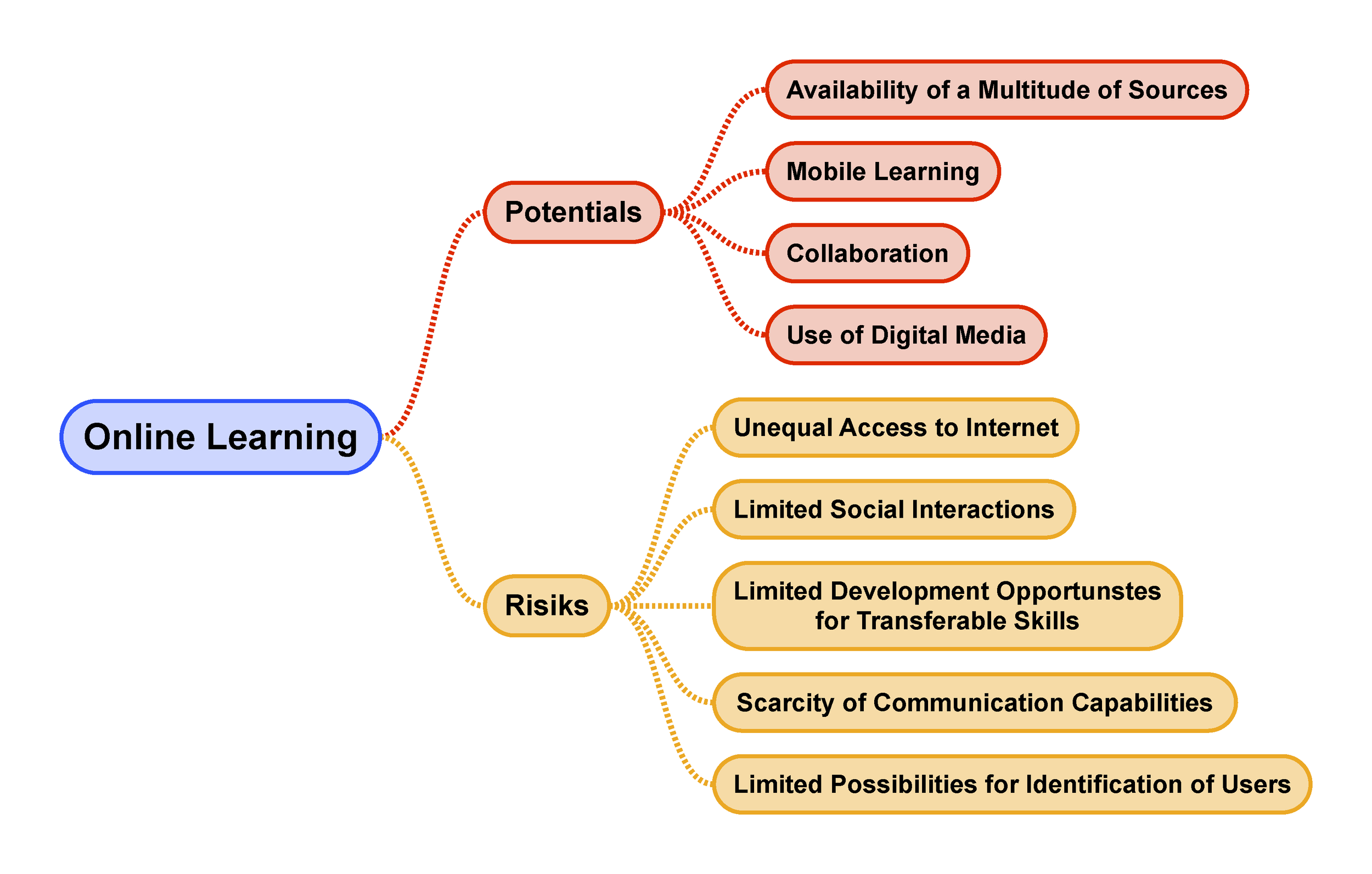This is part one of my series of how to explore the many opportunities of learning and teaching online. The aim of this series is to make you familiar with the basics, potentials and risks, interactive elements, and the strategies you can use to develop and implement successful blended learning environments. Not all students, teachers, academics are aware of the possibilities that were behind online learning. This series provides practical tips and takes you through the process of development of online learning courses. See also part two.
Introduction
The terms distance learning and e-learning are sometimes understood more or less as synonymous with online learning (Moore, Dickson-Deane & Gaylen, 2011). Fundamentally, however, online learning should be distinguished from distance learning and e-learning. Gavriel Salomon (1981) points out that they each have unique characteristics and can play a certain role in teaching and learning. James Gibson (1979) described these characteristics as potentials and meant the characteristics of learning environments that can sustain certain activities. In addition, however, there are also various risks which must also be taken into account:

It is important to be aware that online teaching differs in many ways from teaching in traditional learning contexts. The two environments (online and analogue) allow and limit different types of teaching and learning experiences. Therefore, while it is advantageous to start with the formulation of objectives and general teaching approaches when designing online learning environments or teaching online, it is also important to consider the different ways in which the two environments can be combined. However, it is particularly important to select those teaching and learning activities that work specifically online.
Where does the term online learning come from?
Dealing with online learning is directly related to the development of social constructivism in the 1980s and 1990s. At the forefront of this scientific-theoretical perspective is the process of social appropriation that occurs, for example, in discussion forums and other collaborative working methods. In the UK, for example, online learning was established in the 1990s under the state-funded Teaching and Learning Technology Programme (TLTP). In the USA, the Alfred P. Sloan Foundation supported the development of online programs. Similar member organisations such as the Association for Learning Technology (ALT) in the UK, the Australasian Society for Computers in Learning at Tertiary Level (Ascilite), the European Distance and E-Learning Network (EDEN) and the Consorcio Red de Edicación a Distancia, also known as the Inter-American Distance Learning Consortium (CREAD), and the South Asian Open and Distance Learning Consortium (SACODiL) have emerged in other parts of the world. Increasing technological developments, such as multimedia, live conferencing and social media tools, are enabling new forms of online learning. In the past decade, Massive Open Online Courses (MOOCs) in particular have gained in importance, aiming at unlimited participation and open access to learning resources via the Internet. This has significantly changed the general didactics of higher education, subject and school education.
How effective is online learning?
The importance of online learning has become increasingly important in didactics. But what about its effectiveness? The evaluation of online learning has revealed various effects. It should be noted that the learning process in online courses is different from that in face-to-face courses (Swan, 2003). It has been shown that the so-called „persistence“ in online courses is less pronounced than in face-to-face courses. Xu and Jaggers (2013) found lower persistence rates in online courses (91% online versus 94% presence). Persistence in online courses is generally lower in various educational institutions and courses (Moore & Fetzner, 2009), which poses particular challenges for the development and establishment of online communities. The results of a meta-study by the US Department of Education compared the learning outcomes of online and blended learning with personalised teaching (Means, Toyama, Murphy, Bakia & Jones, 2010) and provides some evidence that learners generally learn at least as well and perhaps slightly better in online environments than in traditional learning environments. In short, the effects in terms of online learning and individual learning vary. Overall, it seems reasonable to look for ways to develop and improve both motivation and stamina as well as online learning outcomes.
Principles for online learning
The following four aspects should be considered when designing online teaching:
- Interactivity: In contrast to face-to-face events or other media, attention must be paid to interaction and collaboration.
- Learning in the context of the Community of Inquiry (CoI)* (Garrison, Anderson & Archer, 2000) emphasises in particular the three components of cognitive, social and teaching presence.
- Blended Learning: Research has shown that learners are more engaged and learn more in blended learning courses than in online or face-to-face courses.
- Technological development: The technologies we use to support online and blended learning, the way we structure online and blended courses, and the business models on which online learning (and indeed university, subject and school didactics) depends are evolving rapidly. This requires constant adaptation of the learning environment.
* CoI is a theoretical model for online learning and comprises the three components mentioned above that should be taken into account when designing online and especially blended learning teaching so that learners can reach a higher level of learning (cf. Bloom’s learning taxonomy; see Krathwohl & Anderson, 2009). Social presence includes, for example, the social and emotional connection between individuals and their own situation within the online learning environment. Cognitive presence describes the extent to which learners can generate, reflect and lead dialogues through teaching activities. In virtual learning environments, teaching presence includes not only the presence of teachers who try to stimulate learners’ learning activities, but also interactions that are self-directed by learners.
References
Garrison, D. R., Anderson, T. & Archer, W. (2000) ‘Critical inquiry in a text-based environment: Computer conferencing in higher education’, in The Internet and Higher Education 11(2): pp.87–105.
Gibson, J. J. (1979) The Ecological Approach to Visual Perception, Boston: Houghton Mifflin.
Krathwohl, D. R., & Anderson, L. W. (2009) A taxonomy for learning, teaching, and assessing: A revision of Bloom’s taxonomy of educational objectives. Longman.
Means, B., Toyama, Y., Murphy, R., Bakia, M. & Jones, K. (2010) Evaluation of Evidence-Based Practices in Online Learning: A Meta-Analysis and Review of Online Learning Studies, Washington, DC: U.S. Department of Education. URL www2.ed.gov/rschstat/eval/tech/evidence-based-practices/finalreport.pdf [21/03/2020].
Moore, J. C. & Fetzner, M. J. (2009) ‘The road to retention: A closer look at institutions that achieve high course completion rates’, in Journal of Asynchronous Learning Networks, 13(3): pp.3–22.
Moore, J. L., Dickson-Deane, C. & Gaylen, K. (2011) ‘e-Learning, online learning, and distance learning environments: Are they the same?’, in The Internet and Higher Education, 14: pp.129–135. URL https://www.academia.edu/6554958/e-Learning_online_learning_and_distance_learning_environments_Are_they_the_same [31/03/2020].
Salomon, G. (1981) The Interaction of Media, Cognition, and Learning, San Francisco: Jossey-Bass.
Swan, K. (2010) ‘Teaching and learning in post-industrial distance education’, in Cleveland-Innes, M. & Garrison, D. R. An Introduction to Distance Education: Teaching and Learning in a New Era, New York, Abingdon, Routledge.
Xu, D. & Jaggers, S. S. (2013) Examining the Effectiveness of Online Learning Within a Community College System: An Instrumental Variable Approach, New York: Community College Research Center, Teachers College, Columbia University.
This series of insights into online learning and teaching was inspired and made possible through an online course from Epigeum.com whose content is not only a solid foundation for the topic but also an exceptional designed blended learning program:
Swan, K. (2014). Teaching Online. Oxford University Press. URL https://www.epigeum.com/courses/teaching/teaching-online/









